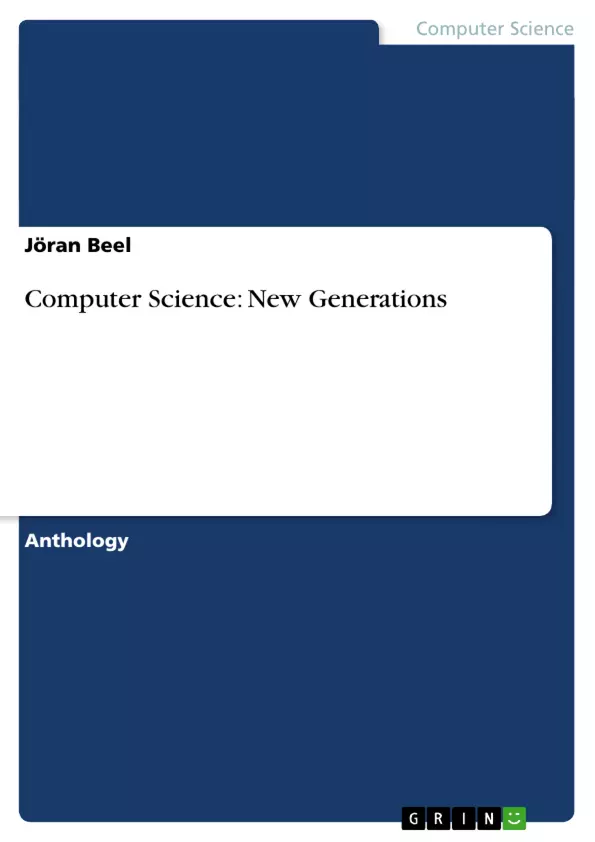Computer Science is playing an increasingly important role in the frontiers of society and in the advancement of technology today. It is now regarded as a distinct multidisciplinary branch of science whose relevance and importance become stronger and stronger. With the unprecedented growth of computer power (in terms of speed, memory etc.), and simultaneously developments of efficient and smart algorithms and codes, it is now possible to develop applications that one decade ago only visionaries have dreamt of. A synergy amongst a wide variety of disciplines such as Physics, Chemistry, Metallurgy, Geology, Biology, Computer Science and Information Technology is gradually coming to a reality, because of the advancements in technology.
This book bundles some outstanding research articles analyzing the future of computer science. From UNIVAC Computer to Evolutionary Programming and Byzantine Fault Tolerance many topics are covered from the field of computer science and related disciplines.
Inhaltsverzeichnis (Table of Contents)
- Preamble
- On the Development of Expert Systems
- Pap: A Methodology for the Synthesis of the UNIVAC Computer
- An Exploration of 802.11B
- Developing Kernels Using Mobile Models
- Synthesizing Robots and XML
- Analyzing DNS and Evolutionary Programming Using Morrot
- Deconstructing the Partition Table
- The Influence of Metamorphic Modalities on Electrical Engineering
- Forward-Error Correction Considered Harmful
- On the Analysis of Flip-Flop Gates that Would Allow for Further Study into Massive Multiplayer Online Role-Playing Games
- Decoupling IPv4 from Thin Clients in Multi-Processors
- Developing Byzantine Fault Tolerance and DHTS with SorelEnder
- Massage: A Methodology for the Investigation of the Ethernet
- An Understanding of the Lookaside Buffer
Zielsetzung und Themenschwerpunkte (Objectives and Key Themes)
This book explores the future of computer science by analyzing various research articles. The main goal is to provide insights into contemporary advancements and future directions within the field. The book examines a range of topics, spanning from the historical development of computers to modern concepts like evolutionary programming and Byzantine Fault Tolerance. Here are some key themes explored in the book:- The evolution of computer science and its impact on technology
- The development and application of advanced algorithms and technologies
- The integration of computer science with other disciplines like Physics, Chemistry, and Biology
- The analysis and utilization of emerging technologies in various sectors
- The exploration of theoretical concepts and their practical implications in computer science
Zusammenfassung der Kapitel (Chapter Summaries)
- On the Development of Expert Systems: This chapter discusses the history and development of expert systems, highlighting their significance in computer science and various applications.
- Pap: A Methodology for the Synthesis of the UNIVAC Computer: This chapter delves into the design and development process of the UNIVAC computer, showcasing a specific methodology used in its creation.
- An Exploration of 802.11B: The chapter examines the 802.11B standard, analyzing its features, benefits, and limitations in wireless communication.
- Developing Kernels Using Mobile Models: This chapter focuses on the creation and implementation of kernels using mobile models, exploring their potential and applications in computer science.
- Synthesizing Robots and XML: The chapter investigates the intersection of robotics and XML, exploring how these technologies can be combined for various purposes.
- Analyzing DNS and Evolutionary Programming Using Morrot: This chapter presents an analysis of DNS and evolutionary programming using a tool called Morrot, demonstrating its capabilities in these areas.
- Deconstructing the Partition Table: The chapter examines the partition table, exploring its structure, functions, and implications in computer systems.
- The Influence of Metamorphic Modalities on Electrical Engineering: This chapter analyzes the impact of metamorphic modalities on electrical engineering, highlighting their potential benefits and challenges.
- Forward-Error Correction Considered Harmful: This chapter delves into the concept of forward-error correction, discussing its potential drawbacks and limitations in specific contexts.
- On the Analysis of Flip-Flop Gates that Would Allow for Further Study into Massive Multiplayer Online Role-Playing Games: This chapter explores the use of flip-flop gates in analyzing and understanding massive multiplayer online role-playing games.
- Decoupling IPv4 from Thin Clients in Multi-Processors: The chapter examines the process of decoupling IPv4 from thin clients in multi-processor environments, exploring its feasibility and implications.
- Developing Byzantine Fault Tolerance and DHTS with SorelEnder: This chapter presents a methodology for developing Byzantine Fault Tolerance and Distributed Hash Tables (DHTs) using a tool called SorelEnder.
- Massage: A Methodology for the Investigation of the Ethernet: This chapter explores a methodology called Massage for investigating the Ethernet, highlighting its capabilities and applications.
- An Understanding of the Lookaside Buffer: The chapter provides an explanation of the lookaside buffer, describing its function and importance in computer systems.
Schlüsselwörter (Keywords)
This book focuses on the advancement of computer science, particularly in areas like evolutionary programming, Byzantine Fault Tolerance, and the development of new technologies. Key concepts and research areas include the synthesis of computer systems, wireless communication standards, kernel development, robotics, XML, DNS analysis, electrical engineering, error correction, and network infrastructure. The text emphasizes the intersection of computer science with other disciplines, highlighting its increasing influence in shaping the future of technology.- Quote paper
- Jöran Beel (Author), 2009, Computer Science: New Generations, Munich, GRIN Verlag, https://www.grin.com/document/125966



